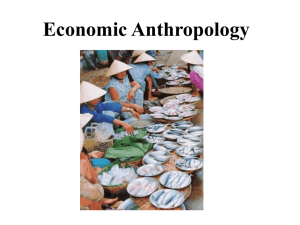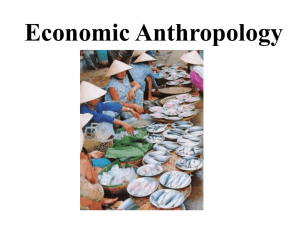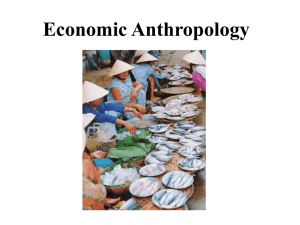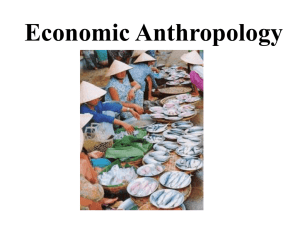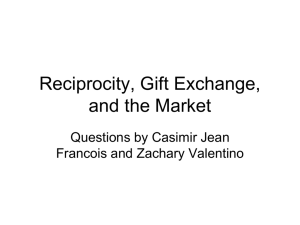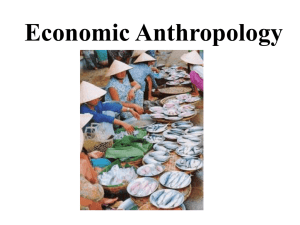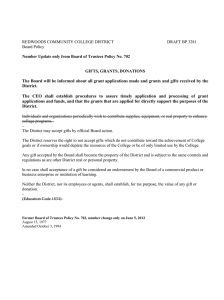Economic Anthropology
advertisement
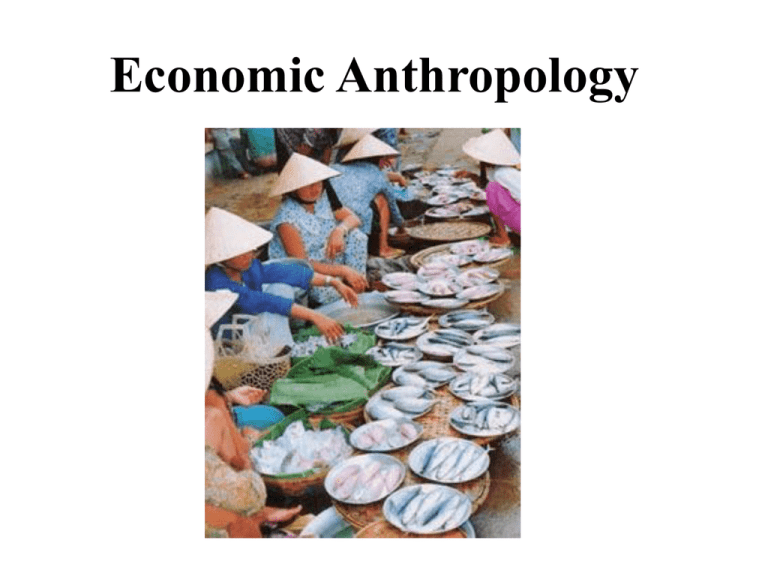
Economic Anthropology Economic Anthropology • Economics is the study of production, distribution, and consumption of resources. • Economic Anthropology studies economics in a comparative perspective. A society’s economy consists of: • • • • Production Consumption Distribution Exchange Economizing and Maximization Classical economic theory assumed that individuals universally acted rationally, by economizing to maximize profits, but comparative data shows that people frequently respond to other motivations than profit. Accumulation of food for a feast. Yams are heaped up on the ground and fill the pwata'i (prism-shaped wooden receptacle): coconuts, sugar cane and bunches of areca nuts are displayed on top - the whole producing on the natives a strong impression of beauty, power and importance. The Trobrianders produce far more yams than they can ever eat and often simply allow them to rot. Why? Exchange “The act of giving or taking one thing in return for another” Exchange is: • The chief means by which useful things move from one person to another • An important way in which people create and maintain relationships and social hierarchy • richly symbolic - all exchanges have got social meaning •fun /exciting • universal • politically charged, • emotionally charged • important in people’s lives • varied What kinds of things are exchanged? In order for social relationships to exist we must exchange something whether it is the communicative exchange of language, the economic and/or ceremonial exchange of goods or the exchange of spouses. i.e. exchange is important for the establishment and maintenance of social relationships “If Friends make gifts, Gifts Make Friends” Marcel Mauss exchange is important for the establishment and maintenance of relationships WHO exchange relationships WHAT what is the significance and meaning of what is exchanged WHERE what is the significance and meaning of where it is exchanged WHEN on what occasions WHY social reasons HOW ceremony, mechanisms, Patterns of exchange and circulation, lead us to the heart of social and cultural organization WHAT IS A GIFT? •What kinds of gifts are there? • When do we give gifts? IS THERE ANY SUCH THING AS A FREE GIFT? WHAT ARE THE CONSEQUENCES OF NOT RECIPROCATING? ARE THERE BONDS OF OBLIGATION? IS THERE SOME COMPETITIVENESS INVOLVED IN GIFT GIVING? HOW DO WE FEEL WHEN WE HAVEN’T RECEIVED A GIFT OF AT LEAST EQUAL VALUE? WHAT IF THE GIFT RETURNED IS OF HIGHER VALUE? Marcel Mauss 1925: The Gift: The Form and Reason for Exchange in Archaic Societies Mauss points to three fields of obligation: to give, to receive and to repay Gifts, according to Mauss, create relationships not only between individuals but between groups, relationships which take the form of total prestations 1872 - 1950 What rule of legality and self-interest, in societies of a backward or archaic type, compels the gift that has been received to be obligatorily reciprocated? What power resides in the object given that causes its recipient to pay it back?” (Mauss 1925) The Potlatch A form of ceremonial exchange of gifts employed by indigenous groups on NW coast of BC (Tlingit, Haida, Tsimshian and Kwakiutl (Kwakwaka'wakw)) Both sexes wore cedar-bark or fur robes with one or both shoulders covered, and women had in addition bark aprons extending from the waist to the knees of cedar bark or goat-hair cords. Water-proof capes and hats were made of bark. Crossing the strait "Interior of Habitation at Nootka Sound" John Webber (British), April 1778 The Kwakiutl house is constructed of cedar boards on a framework of heavy logs. The ridge extends from front to back, the roof-boards run from ridge to eave, and the wall boards are perpendicular. POTLATCH held in connection with events in the life cycle, initiations, marriages, house building, funerals, assumption of certain dance privileges. extravagant and lavish preparations including much food preparation and the creation of masks and art work are made by the host as gifts for the guests The word means ‘to feed’ or ‘to consume’ Potlatch at Fort Rupert, British Columbia, 1898 A Kwakiutl clan chief wore this mask when greeting rival chiefs invited for a potlatch. It reminded the guests of their host's great riches and their indebtedness to his generosity. This Kwakiutl mask represents a mythic ogress of the forest. Dz'onokwa, who skulked through villages at night to steal children to eat. She was also the "master of wealth," represented by the copper of her eyebrows, and so an appropriate symbol for the ceremonial feast. The most central symbol of wealth, power and prestige is the copper, a shield-shaped plate of beaten copper that usually has a painted or engraved representation of a crest animal on its surface. Contemporary coppers as well as older ones frequently bear animal names - Sea Lion, Beaver face - probably referring to the crest of their original owners. The Kwakiutl chief Tulthidi prepares to give away his valuable copper in honor of his son Broken copper Tsimshian: Gitsan, British Columbia Collected by G.T. Emmons, prior to 1914 Chilkat Blanket" 1890-1900, Tlingit •Because of all the gifts, a traditional potlatch took years to prepare •A large potlatch held in 1921 was said to take 17 years of preparation • A modern day potlatch may take about a year to prepare and cost $10,000. C. 1900 Today potlatch gifts include coffee mugs, socks, hand knit blankets and clothes, as well as carved masks and murals Parties, as they are now sometimes called, commemorate a significant event in an extended family's or clan's collective life. They are held today for baby showers, namings, weddings, anniversaries, special birthdays, graduations, and as memorials for the dead Twined grass basket Nootka/Makah, British Columbia/Washington Cedar carrying basket with handles Why would they spend years accumulating wealth only to give it away - or even throw the objects into the sea? Social Significance potlatch celebrations are a significant representation of the host's status and the display of rank and title In return for giving away food and wealth they get recognition of their status and that of their lineage. Marriages for one’s children and places in the brotherhoods are only won during the potlatch Potlatches become very competitive aspiring leaders use competitive potlatching to move up the system. The potlatch is a system of gift exchange--- material goods are exchanged for social recognition and power The obligation to give The obligation to receive The obligation to reciprocate Prestation • More than simple exchange • Also includes reciprocity and the various obligations • ‘total social phenomenon’ • It is not individuals but collectives that impose obligations of exchange and contract upon each other • What is exchanged is not solely property and wealth Thomas and Jane Carlyle’s Christmas Presents • Renowned 19th century English historian and essayist • Spent Christmas in the 1850s with Lord and Lady Ashburton (wealthy Scottish banker) • In 1851 The Ashburton’s gave Christmas presents to the Carlyles • Mrs Carlyle got a scarf and a bracelet • Thomas got a jigsaw puzzle • both were well received •In 1855 Mrs Carlyle received a black silk dress - A novelty because it was only recently that they were produced by machine • Mrs Carlyle claimed that she was being insulted. What do we have to know to be able to understand those meanings attributed to these gifts? class, social mobility, matrimony, patronage, employment, manufacturing processes, issues of style, conventions of gift-giving. Gift Exchange does not operate according to market laws, but the social rules of power, symbol, convention, etiquette, ritual, role and status. Economic Anthropology: Substantivist Formalists -economic affairs are embedded in social institutions and cannot be studied separately from other social institutions social structures •kinship system •political structure •religious ideologies -people in nonindustrial economies function with different logic than capitalist economies. Exchanges occur for reasons other than economic benefit •culturally unique values •group benefits •“rational” culturally relative •maximization of personal gain •supply-demand relationships •“rational” decision-making •individual self interest •economy can be analyzed independent of other social structures and institutions •research tools of western economics applicable Economic interactions are social interactions. • the flow of goods indicates social relations Raffia Cloth among the Lele (Zaire) The movement of raffia cloth among the Lele is another example of the mediation of status by goods. Younger men need raffia to marry. But raffia is made and controlled by older men. In order to have access to raffia and hence marriage, younger men need the social approval of older men. Since more raffia is required to marry than any one man can produce, it takes community approval to marry. In modern economy, men can gain access to raffia through wage labor. This undercuts authority of elders and leads to charges of the selling of brides. Karl Polanyi Divided economies into three types according to the dominant mode of distribution reciprocity-- The return of a gift or prestation redistribution -- collection from members of a group and then redistribution within this group. E.g. tribute, taxes market --involves money and profit 1886-1964 Distribution and Exchange • reciprocity • redistribution • market principle Marshal Sahlins Stone Age Economics (1972) •A material transaction is usually a momentary episode in a continuous social relation. • The social relation governs the nature of the immediate exchange and the flow of goods • Sahlins suggests that there are 3 types of reciprocity that form a continuum that correlates with kinship and social distance. 1930- Reciprocity: exchange between social equals • Generalized • Balanced • Negative Generalized reciprocity • e.g. gifts, or sharing, helping, generosity. • between close kin and friends • highly moral – no expectation of return • Generalized reciprocity is correlated with Rank relative wealth and need food Geographic distance Balanced reciprocity • return expected • delayed exchange • maintains ties with more distant people • A precise balance between the things exchanged • Important in e.g.. peace making death payments and marriage alliances. Kula Ring Kula Ring: vast inter-island system of exchange of certain classes of ritual objects — men’s armbands and bracelets – exchange within Massim linguistic group – not a system of “commercial trade” in utilitarian objects (most islands self-sufficient in staple foods & goods) – objects acquired, displayed, and then passed on mwali soulava Like the crown jewels, their value is symbolic There is no practical utility Each valuable has its own name and history Owning them provides the owner prestige and pride at each meeting, “visiting” partner bestows gift on home partner the same object that he received from his other partner a few months or years earlier over time, value (rarity) of objects exchanged increases, as does renown of the partners necklaces A B C D A B C D armbands Kula Ring had been cited as an example of the economic irrationality of “savages”… –took great risks for “fanciful” ends –not survival or commerce, but to obtain “baubles” –pursued out of “sheer habit” the Kula Ring is a vital institution which contributes to the security and continuity of Massim cultures –needs to be seen within the total context of Massim society –ripped out of context, it appears irrational, “savage” intertribal tribe village lineage family social distance determines the nature of the exchange Negative Reciprocity • less common • impersonal, distrustful • not based on ongoing social relations • exchange without money • taking items by force Haggling at the market of Riobamba, Ecuador Reciprocity: Generalized Balanced value unspecified return not immediate long term view no gratitude expected Creating AND satisfying obligations Equal value Expectation of immediate return Similar to trade or barter Common in more distant kin relationships Negative Personal gain is primary motivator something for nothing - haggling - bargaining - theft/seizure - cheating Self Interest Prevalence in band societies Redistribution Exchange among social unequals •centralized accumulation and reallocation of wealth (taxes, tributes, tithes, spoils) –maintain power, superior status (internally) –keep constituents happy, maintain standard of living –use wealth to leverage power (externally) –leveling mechanisms •typical mode of exchange in chiefdoms and some nonindustrial states These workers in Yunnan Province, China, strive for an equal distribution of meat. Redistribution in Western Society Taxes Food Bank Market exchange –value preset by impersonal “market forces” –exchange occurs presumably independent of and uninfluenced by social relations –usually involves money, a widely agreed on abstract symbol used to measure value
